Factors Motivating Consumers to Pay High Price for Better Brand Value
VerifiedAdded on 2023/06/11
|19
|4518
|429
AI Summary
This research proposal investigates the factors that motivate consumers to pay high price for better brand value. The study focuses on social, cultural, psychological, and personal factors that influence consumer behavior. The research aims to analyze the relationship between brand value and consumer attitude and purchasing behavior.
Contribute Materials
Your contribution can guide someone’s learning journey. Share your
documents today.
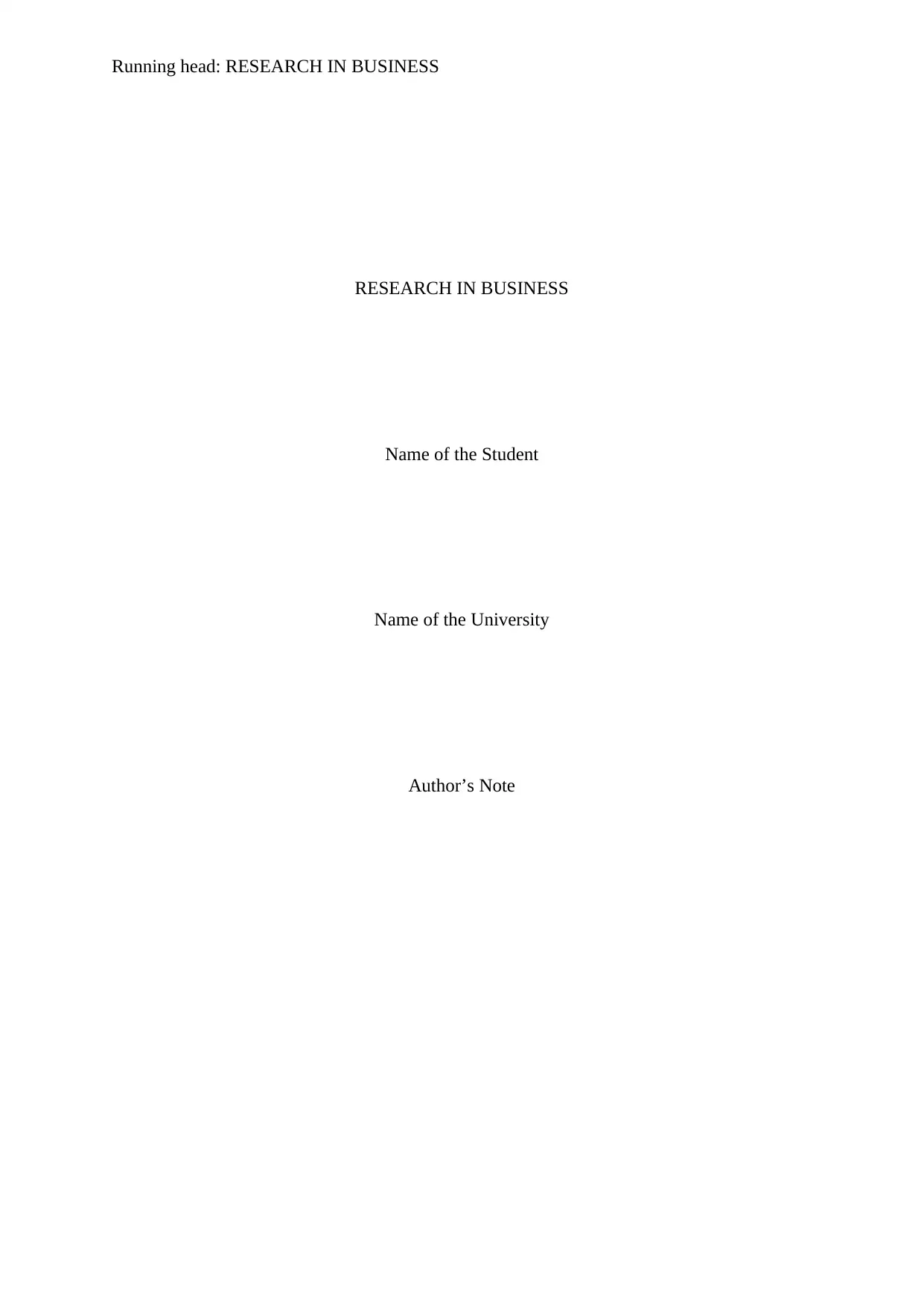
Running head: RESEARCH IN BUSINESS
RESEARCH IN BUSINESS
Name of the Student
Name of the University
Author’s Note
RESEARCH IN BUSINESS
Name of the Student
Name of the University
Author’s Note
Secure Best Marks with AI Grader
Need help grading? Try our AI Grader for instant feedback on your assignments.
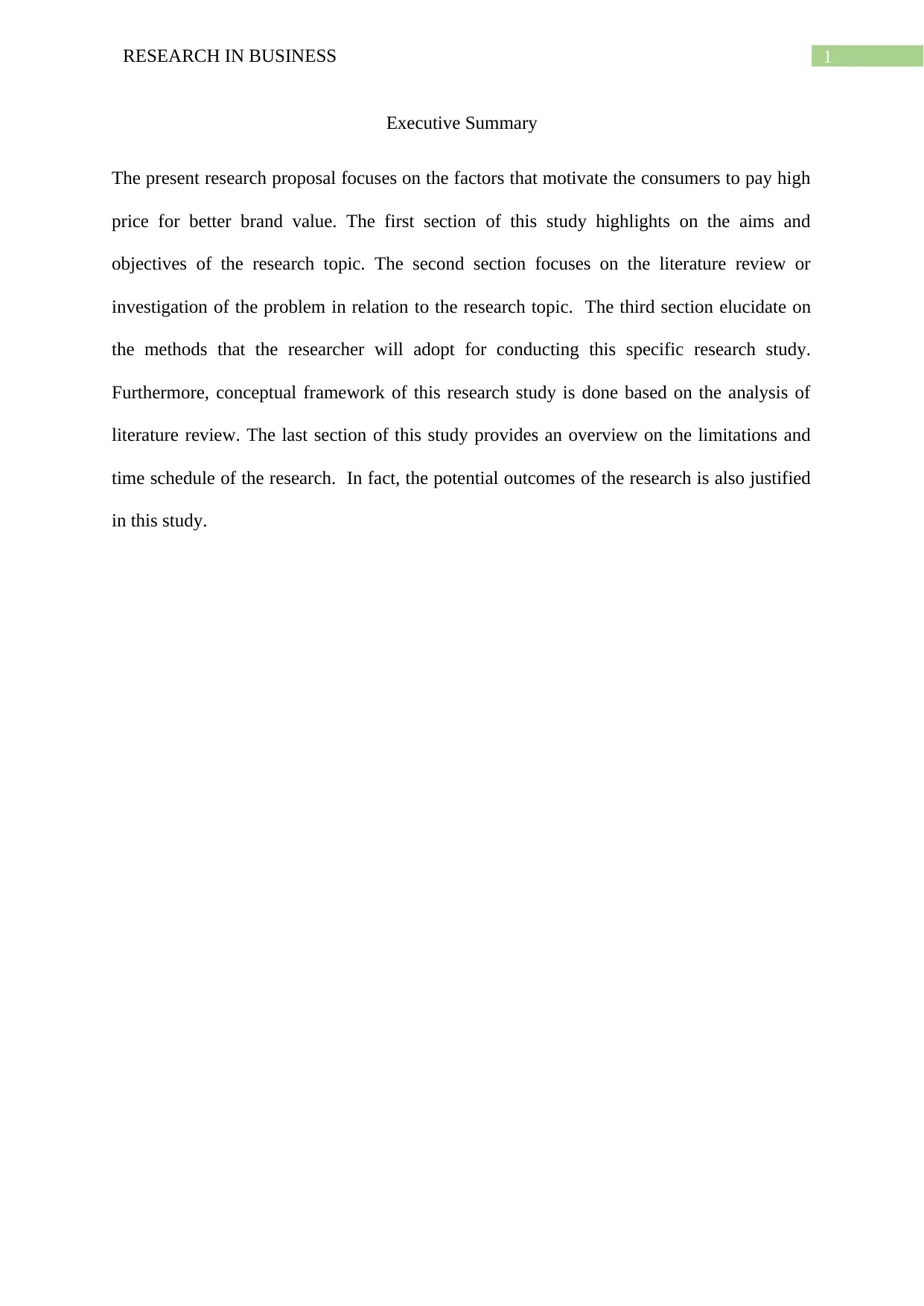
1RESEARCH IN BUSINESS
Executive Summary
The present research proposal focuses on the factors that motivate the consumers to pay high
price for better brand value. The first section of this study highlights on the aims and
objectives of the research topic. The second section focuses on the literature review or
investigation of the problem in relation to the research topic. The third section elucidate on
the methods that the researcher will adopt for conducting this specific research study.
Furthermore, conceptual framework of this research study is done based on the analysis of
literature review. The last section of this study provides an overview on the limitations and
time schedule of the research. In fact, the potential outcomes of the research is also justified
in this study.
Executive Summary
The present research proposal focuses on the factors that motivate the consumers to pay high
price for better brand value. The first section of this study highlights on the aims and
objectives of the research topic. The second section focuses on the literature review or
investigation of the problem in relation to the research topic. The third section elucidate on
the methods that the researcher will adopt for conducting this specific research study.
Furthermore, conceptual framework of this research study is done based on the analysis of
literature review. The last section of this study provides an overview on the limitations and
time schedule of the research. In fact, the potential outcomes of the research is also justified
in this study.
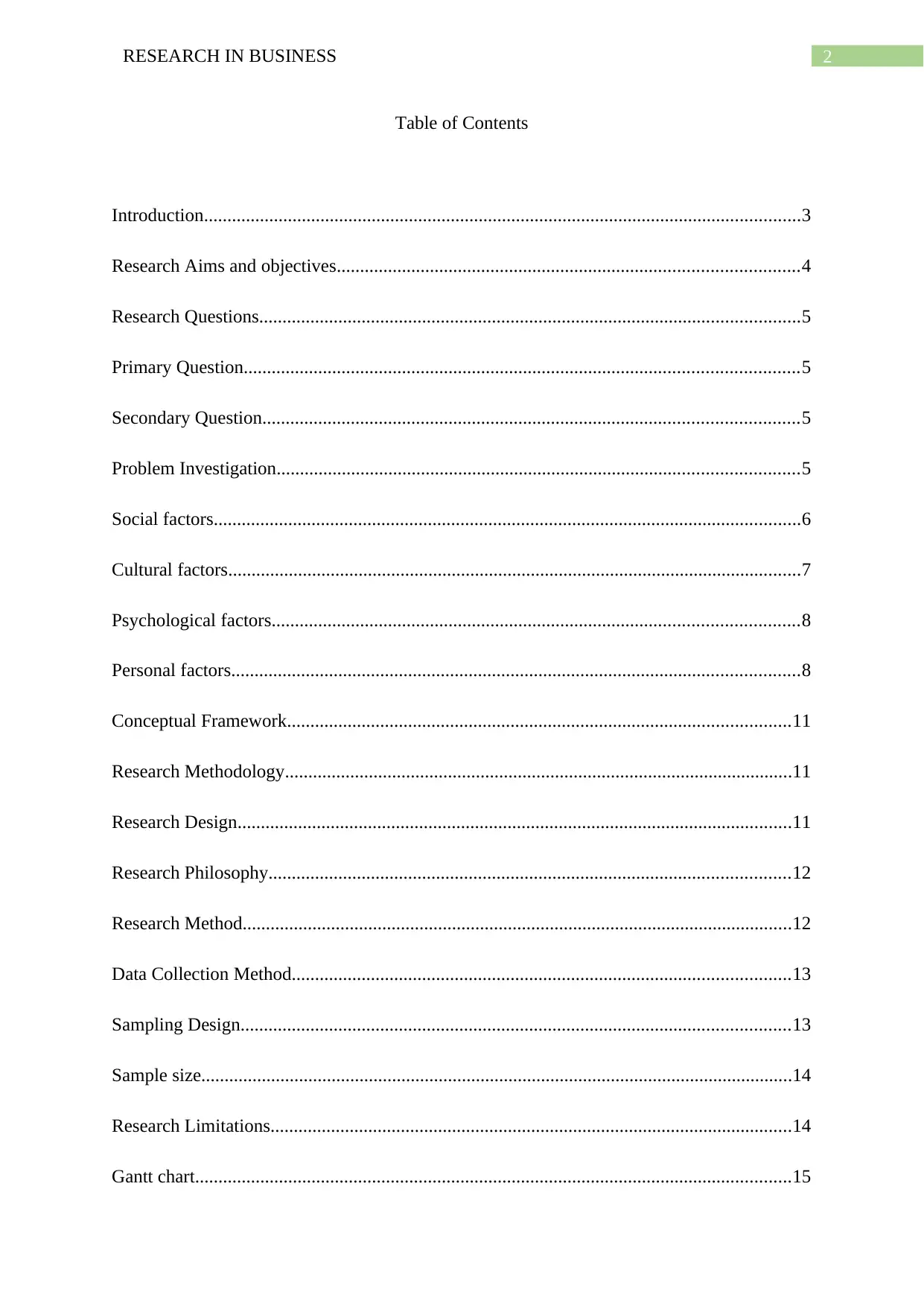
2RESEARCH IN BUSINESS
Table of Contents
Introduction................................................................................................................................3
Research Aims and objectives...................................................................................................4
Research Questions....................................................................................................................5
Primary Question.......................................................................................................................5
Secondary Question...................................................................................................................5
Problem Investigation................................................................................................................5
Social factors..............................................................................................................................6
Cultural factors...........................................................................................................................7
Psychological factors.................................................................................................................8
Personal factors..........................................................................................................................8
Conceptual Framework............................................................................................................11
Research Methodology.............................................................................................................11
Research Design.......................................................................................................................11
Research Philosophy................................................................................................................12
Research Method......................................................................................................................12
Data Collection Method...........................................................................................................13
Sampling Design......................................................................................................................13
Sample size...............................................................................................................................14
Research Limitations................................................................................................................14
Gantt chart................................................................................................................................15
Table of Contents
Introduction................................................................................................................................3
Research Aims and objectives...................................................................................................4
Research Questions....................................................................................................................5
Primary Question.......................................................................................................................5
Secondary Question...................................................................................................................5
Problem Investigation................................................................................................................5
Social factors..............................................................................................................................6
Cultural factors...........................................................................................................................7
Psychological factors.................................................................................................................8
Personal factors..........................................................................................................................8
Conceptual Framework............................................................................................................11
Research Methodology.............................................................................................................11
Research Design.......................................................................................................................11
Research Philosophy................................................................................................................12
Research Method......................................................................................................................12
Data Collection Method...........................................................................................................13
Sampling Design......................................................................................................................13
Sample size...............................................................................................................................14
Research Limitations................................................................................................................14
Gantt chart................................................................................................................................15
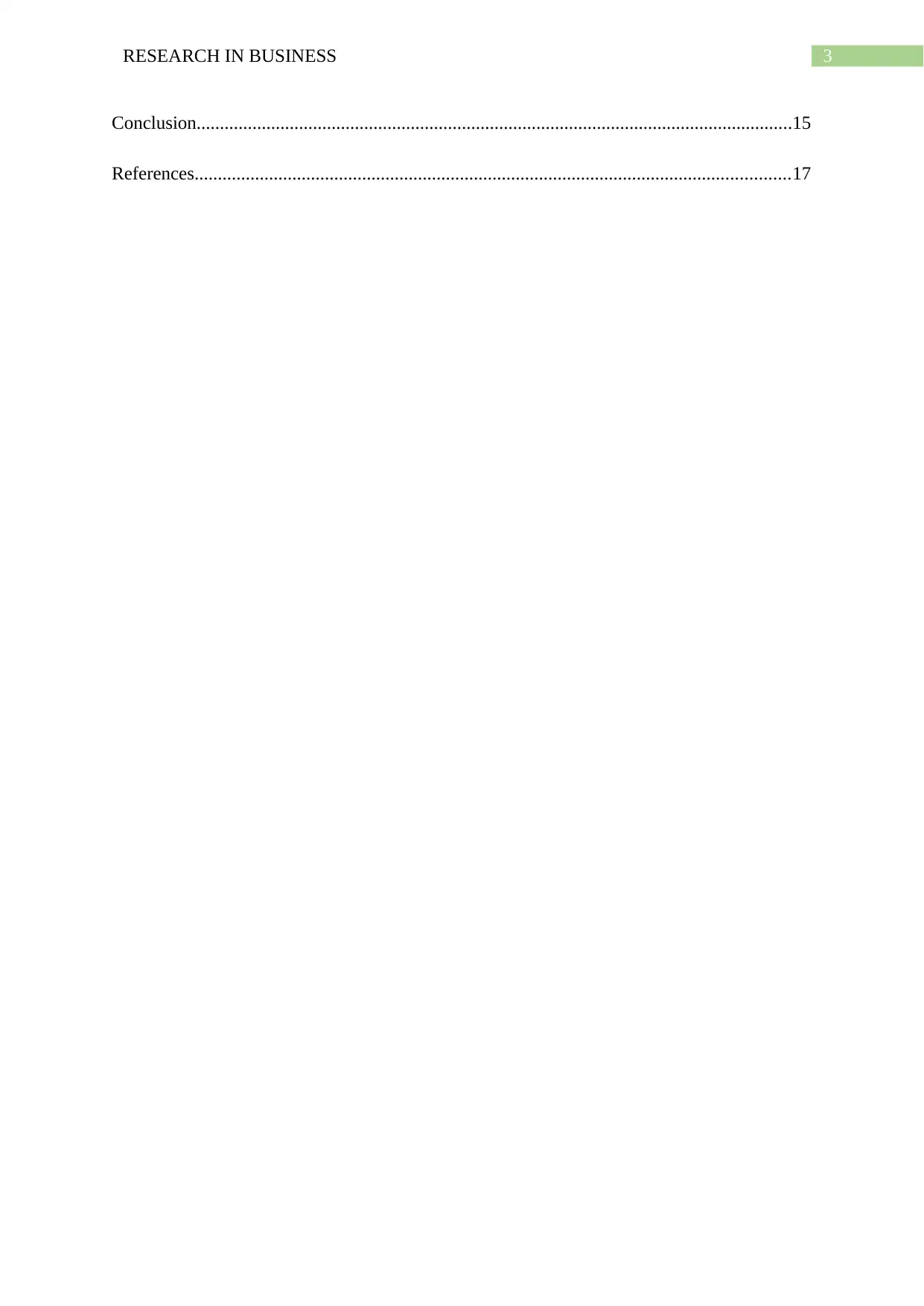
3RESEARCH IN BUSINESS
Conclusion................................................................................................................................15
References................................................................................................................................17
Conclusion................................................................................................................................15
References................................................................................................................................17
Secure Best Marks with AI Grader
Need help grading? Try our AI Grader for instant feedback on your assignments.

4RESEARCH IN BUSINESS
Introduction
The present research study investigates about the factors motivating consumers to pay
higher prices for better brand value. Now- a- days the enterprises are more concerned about
the consumers behaviour as it facilitates them to attain information regarding the consumers
preference, taste and their way of thinking relating to selection of products. As the
preferences and way of thinking vary among the consumers, their decision for purchasing of
luxury product and essential product vary in higher way. Consumer behaviour refers to the
study of processes that is involved when an individual or groups chooses, purchases and
disposes of the commodities and services in order to satisfy their needs as well as desires
(Boztepe, 2012). The purchase behaviour of the consumers is usually analysed by the
organizations in order to draw the conclusive decision relating to their preference in brand.
Brands play one of the vital role in consumer’s decision making regarding product selection
and price. There are several factors that influences the view as well as decision making of the
consumers. In the today’s competitive marketplace, consumers vary in their perceptions and
thereby holds varying images about any particular brand. However, the consumers often have
to make choice among huge range of brands or commodities in the marketplace, which differ
slightly in its price. In such situations, the consumer’s final decision mainly depends on
image that is associated with various brands.
Brand image has been considered as one of the vital factors that influences the
consumer purchasing behaviour relating to better brand value (Aaker & Biel, 2013). Several
researchers demonstrates that brand image is crucial in apparel buying behaviour as it affects
customer willingness in paying premium price as well as recommending the brands to other
people. Moreover, when the customers hold constructive as well as strong brand image, they
becomes more likely to assess apparel goods in positive way irrespective of price. In this
specific research study, more focus has been given on higher brand value products that is
Introduction
The present research study investigates about the factors motivating consumers to pay
higher prices for better brand value. Now- a- days the enterprises are more concerned about
the consumers behaviour as it facilitates them to attain information regarding the consumers
preference, taste and their way of thinking relating to selection of products. As the
preferences and way of thinking vary among the consumers, their decision for purchasing of
luxury product and essential product vary in higher way. Consumer behaviour refers to the
study of processes that is involved when an individual or groups chooses, purchases and
disposes of the commodities and services in order to satisfy their needs as well as desires
(Boztepe, 2012). The purchase behaviour of the consumers is usually analysed by the
organizations in order to draw the conclusive decision relating to their preference in brand.
Brands play one of the vital role in consumer’s decision making regarding product selection
and price. There are several factors that influences the view as well as decision making of the
consumers. In the today’s competitive marketplace, consumers vary in their perceptions and
thereby holds varying images about any particular brand. However, the consumers often have
to make choice among huge range of brands or commodities in the marketplace, which differ
slightly in its price. In such situations, the consumer’s final decision mainly depends on
image that is associated with various brands.
Brand image has been considered as one of the vital factors that influences the
consumer purchasing behaviour relating to better brand value (Aaker & Biel, 2013). Several
researchers demonstrates that brand image is crucial in apparel buying behaviour as it affects
customer willingness in paying premium price as well as recommending the brands to other
people. Moreover, when the customers hold constructive as well as strong brand image, they
becomes more likely to assess apparel goods in positive way irrespective of price. In this
specific research study, more focus has been given on higher brand value products that is
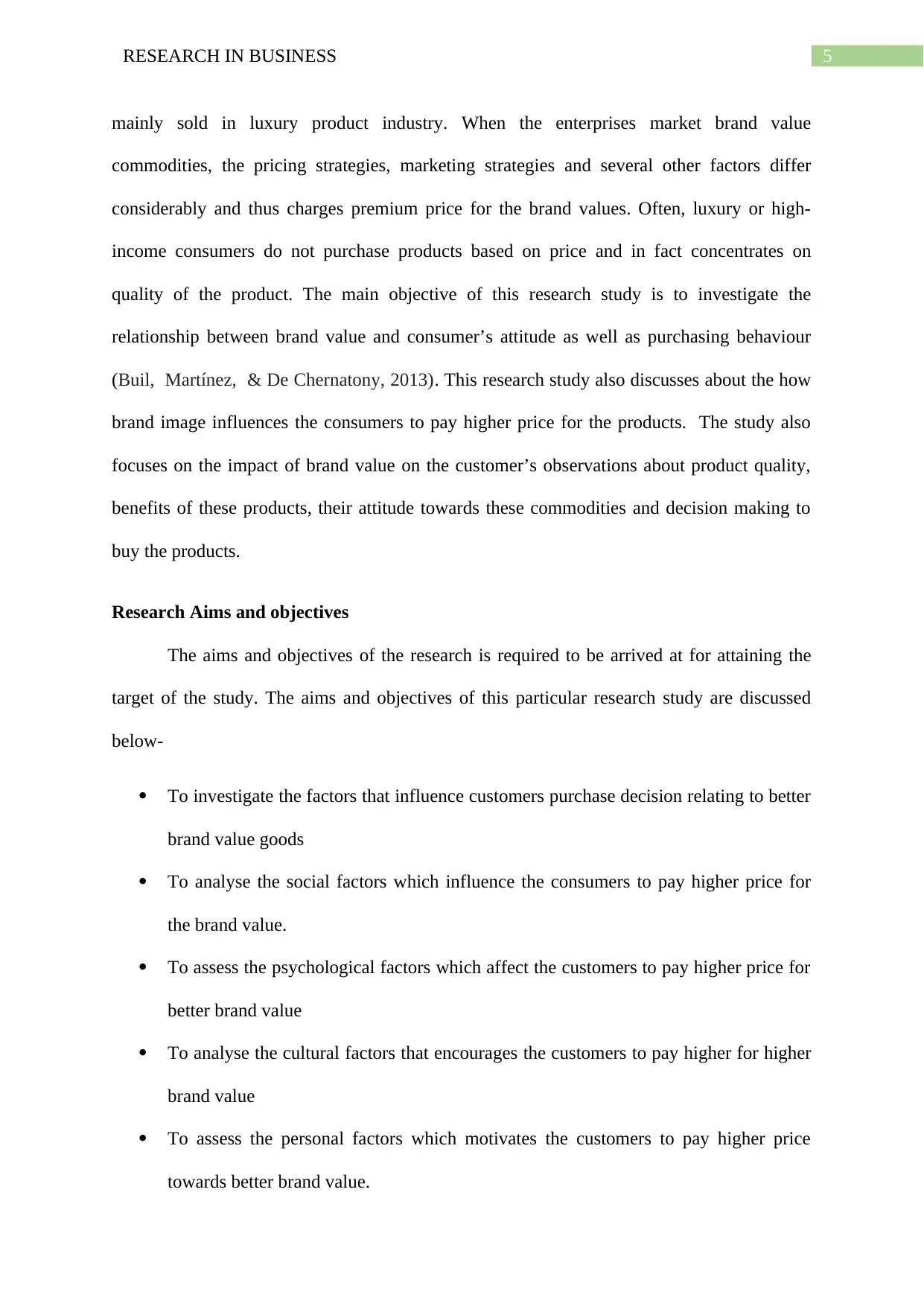
5RESEARCH IN BUSINESS
mainly sold in luxury product industry. When the enterprises market brand value
commodities, the pricing strategies, marketing strategies and several other factors differ
considerably and thus charges premium price for the brand values. Often, luxury or high-
income consumers do not purchase products based on price and in fact concentrates on
quality of the product. The main objective of this research study is to investigate the
relationship between brand value and consumer’s attitude as well as purchasing behaviour
(Buil, Martínez, & De Chernatony, 2013). This research study also discusses about the how
brand image influences the consumers to pay higher price for the products. The study also
focuses on the impact of brand value on the customer’s observations about product quality,
benefits of these products, their attitude towards these commodities and decision making to
buy the products.
Research Aims and objectives
The aims and objectives of the research is required to be arrived at for attaining the
target of the study. The aims and objectives of this particular research study are discussed
below-
To investigate the factors that influence customers purchase decision relating to better
brand value goods
To analyse the social factors which influence the consumers to pay higher price for
the brand value.
To assess the psychological factors which affect the customers to pay higher price for
better brand value
To analyse the cultural factors that encourages the customers to pay higher for higher
brand value
To assess the personal factors which motivates the customers to pay higher price
towards better brand value.
mainly sold in luxury product industry. When the enterprises market brand value
commodities, the pricing strategies, marketing strategies and several other factors differ
considerably and thus charges premium price for the brand values. Often, luxury or high-
income consumers do not purchase products based on price and in fact concentrates on
quality of the product. The main objective of this research study is to investigate the
relationship between brand value and consumer’s attitude as well as purchasing behaviour
(Buil, Martínez, & De Chernatony, 2013). This research study also discusses about the how
brand image influences the consumers to pay higher price for the products. The study also
focuses on the impact of brand value on the customer’s observations about product quality,
benefits of these products, their attitude towards these commodities and decision making to
buy the products.
Research Aims and objectives
The aims and objectives of the research is required to be arrived at for attaining the
target of the study. The aims and objectives of this particular research study are discussed
below-
To investigate the factors that influence customers purchase decision relating to better
brand value goods
To analyse the social factors which influence the consumers to pay higher price for
the brand value.
To assess the psychological factors which affect the customers to pay higher price for
better brand value
To analyse the cultural factors that encourages the customers to pay higher for higher
brand value
To assess the personal factors which motivates the customers to pay higher price
towards better brand value.
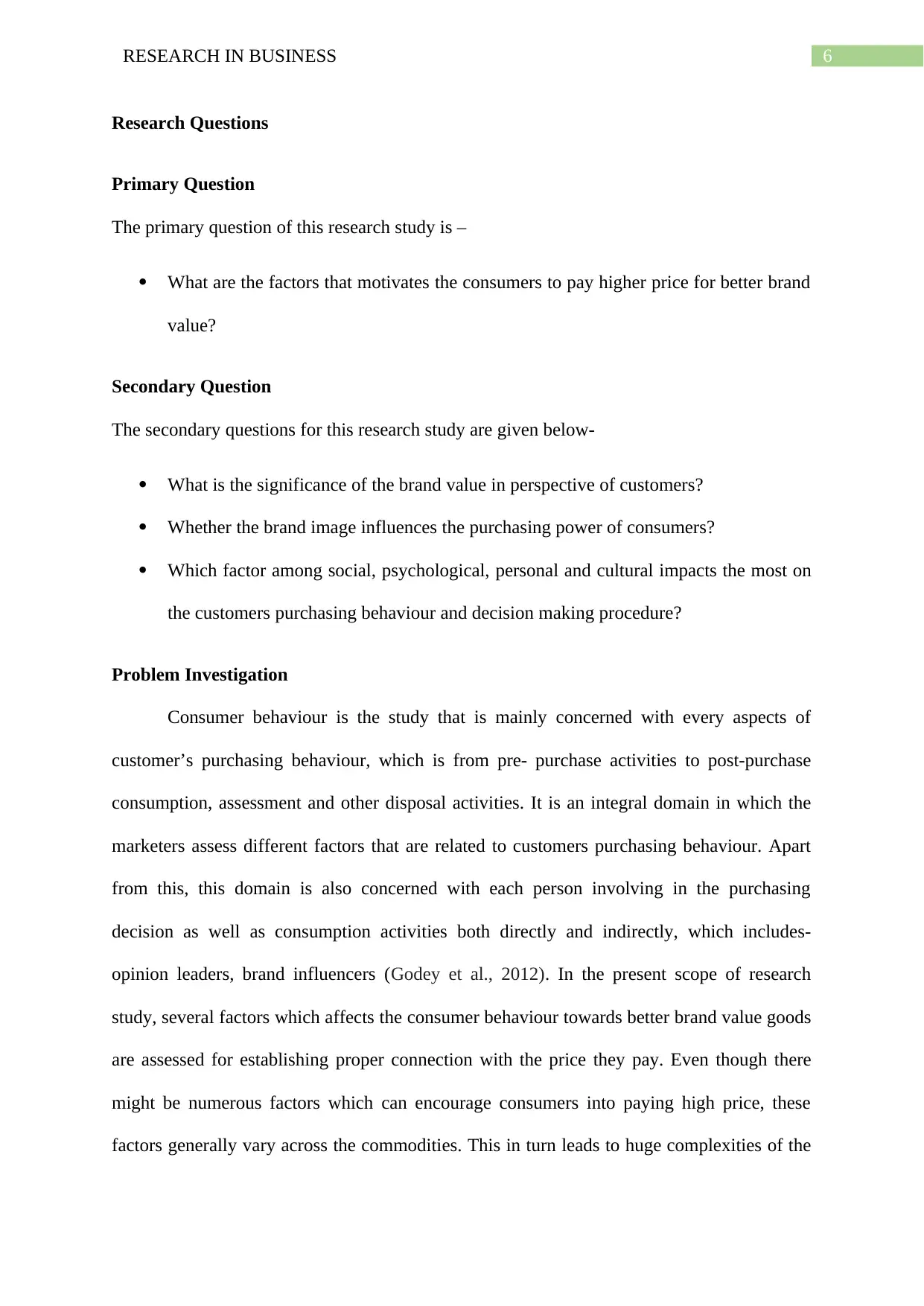
6RESEARCH IN BUSINESS
Research Questions
Primary Question
The primary question of this research study is –
What are the factors that motivates the consumers to pay higher price for better brand
value?
Secondary Question
The secondary questions for this research study are given below-
What is the significance of the brand value in perspective of customers?
Whether the brand image influences the purchasing power of consumers?
Which factor among social, psychological, personal and cultural impacts the most on
the customers purchasing behaviour and decision making procedure?
Problem Investigation
Consumer behaviour is the study that is mainly concerned with every aspects of
customer’s purchasing behaviour, which is from pre- purchase activities to post-purchase
consumption, assessment and other disposal activities. It is an integral domain in which the
marketers assess different factors that are related to customers purchasing behaviour. Apart
from this, this domain is also concerned with each person involving in the purchasing
decision as well as consumption activities both directly and indirectly, which includes-
opinion leaders, brand influencers (Godey et al., 2012). In the present scope of research
study, several factors which affects the consumer behaviour towards better brand value goods
are assessed for establishing proper connection with the price they pay. Even though there
might be numerous factors which can encourage consumers into paying high price, these
factors generally vary across the commodities. This in turn leads to huge complexities of the
Research Questions
Primary Question
The primary question of this research study is –
What are the factors that motivates the consumers to pay higher price for better brand
value?
Secondary Question
The secondary questions for this research study are given below-
What is the significance of the brand value in perspective of customers?
Whether the brand image influences the purchasing power of consumers?
Which factor among social, psychological, personal and cultural impacts the most on
the customers purchasing behaviour and decision making procedure?
Problem Investigation
Consumer behaviour is the study that is mainly concerned with every aspects of
customer’s purchasing behaviour, which is from pre- purchase activities to post-purchase
consumption, assessment and other disposal activities. It is an integral domain in which the
marketers assess different factors that are related to customers purchasing behaviour. Apart
from this, this domain is also concerned with each person involving in the purchasing
decision as well as consumption activities both directly and indirectly, which includes-
opinion leaders, brand influencers (Godey et al., 2012). In the present scope of research
study, several factors which affects the consumer behaviour towards better brand value goods
are assessed for establishing proper connection with the price they pay. Even though there
might be numerous factors which can encourage consumers into paying high price, these
factors generally vary across the commodities. This in turn leads to huge complexities of the
Paraphrase This Document
Need a fresh take? Get an instant paraphrase of this document with our AI Paraphraser
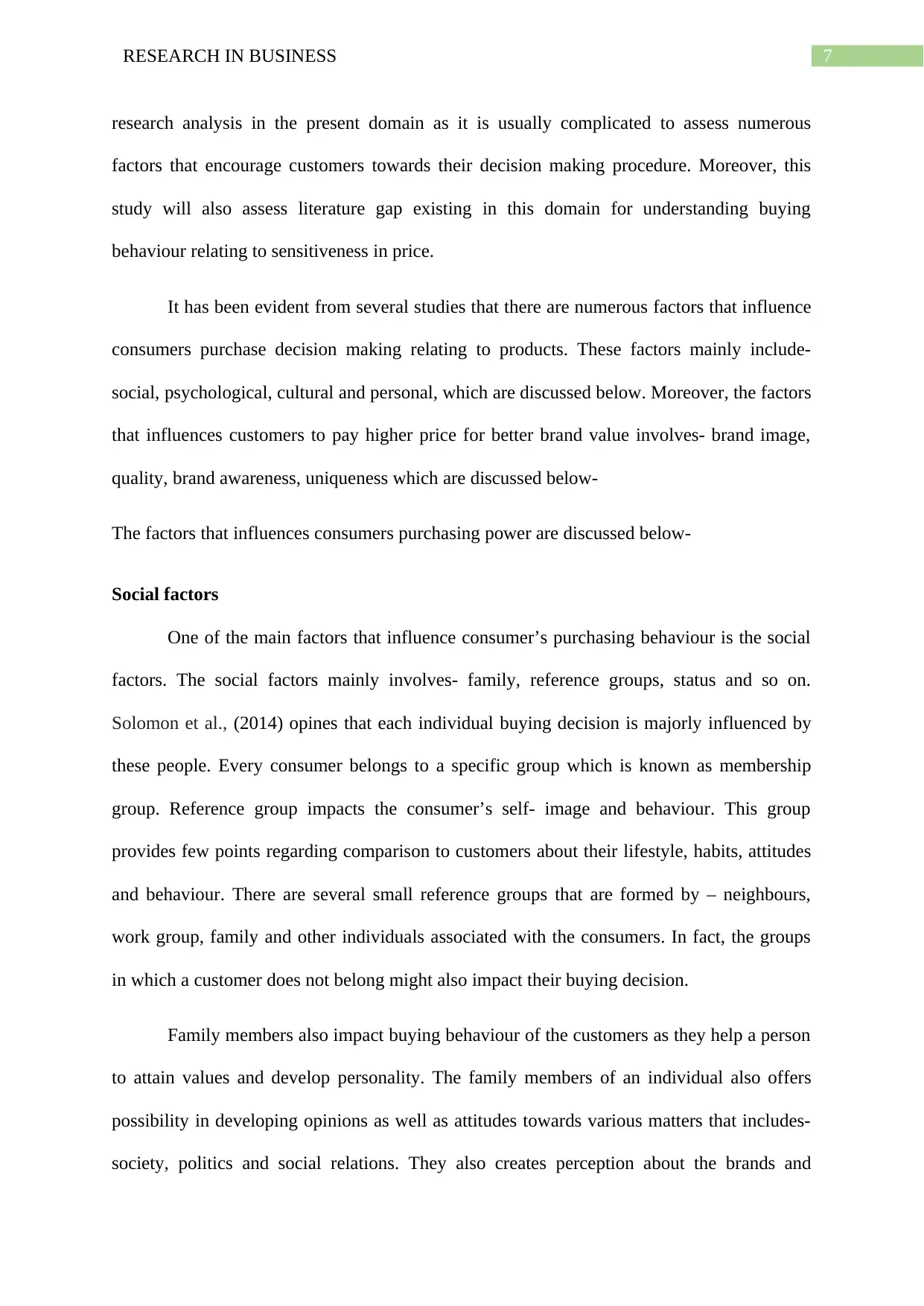
7RESEARCH IN BUSINESS
research analysis in the present domain as it is usually complicated to assess numerous
factors that encourage customers towards their decision making procedure. Moreover, this
study will also assess literature gap existing in this domain for understanding buying
behaviour relating to sensitiveness in price.
It has been evident from several studies that there are numerous factors that influence
consumers purchase decision making relating to products. These factors mainly include-
social, psychological, cultural and personal, which are discussed below. Moreover, the factors
that influences customers to pay higher price for better brand value involves- brand image,
quality, brand awareness, uniqueness which are discussed below-
The factors that influences consumers purchasing power are discussed below-
Social factors
One of the main factors that influence consumer’s purchasing behaviour is the social
factors. The social factors mainly involves- family, reference groups, status and so on.
Solomon et al., (2014) opines that each individual buying decision is majorly influenced by
these people. Every consumer belongs to a specific group which is known as membership
group. Reference group impacts the consumer’s self- image and behaviour. This group
provides few points regarding comparison to customers about their lifestyle, habits, attitudes
and behaviour. There are several small reference groups that are formed by – neighbours,
work group, family and other individuals associated with the consumers. In fact, the groups
in which a customer does not belong might also impact their buying decision.
Family members also impact buying behaviour of the customers as they help a person
to attain values and develop personality. The family members of an individual also offers
possibility in developing opinions as well as attitudes towards various matters that includes-
society, politics and social relations. They also creates perception about the brands and
research analysis in the present domain as it is usually complicated to assess numerous
factors that encourage customers towards their decision making procedure. Moreover, this
study will also assess literature gap existing in this domain for understanding buying
behaviour relating to sensitiveness in price.
It has been evident from several studies that there are numerous factors that influence
consumers purchase decision making relating to products. These factors mainly include-
social, psychological, cultural and personal, which are discussed below. Moreover, the factors
that influences customers to pay higher price for better brand value involves- brand image,
quality, brand awareness, uniqueness which are discussed below-
The factors that influences consumers purchasing power are discussed below-
Social factors
One of the main factors that influence consumer’s purchasing behaviour is the social
factors. The social factors mainly involves- family, reference groups, status and so on.
Solomon et al., (2014) opines that each individual buying decision is majorly influenced by
these people. Every consumer belongs to a specific group which is known as membership
group. Reference group impacts the consumer’s self- image and behaviour. This group
provides few points regarding comparison to customers about their lifestyle, habits, attitudes
and behaviour. There are several small reference groups that are formed by – neighbours,
work group, family and other individuals associated with the consumers. In fact, the groups
in which a customer does not belong might also impact their buying decision.
Family members also impact buying behaviour of the customers as they help a person
to attain values and develop personality. The family members of an individual also offers
possibility in developing opinions as well as attitudes towards various matters that includes-
society, politics and social relations. They also creates perception about the brands and
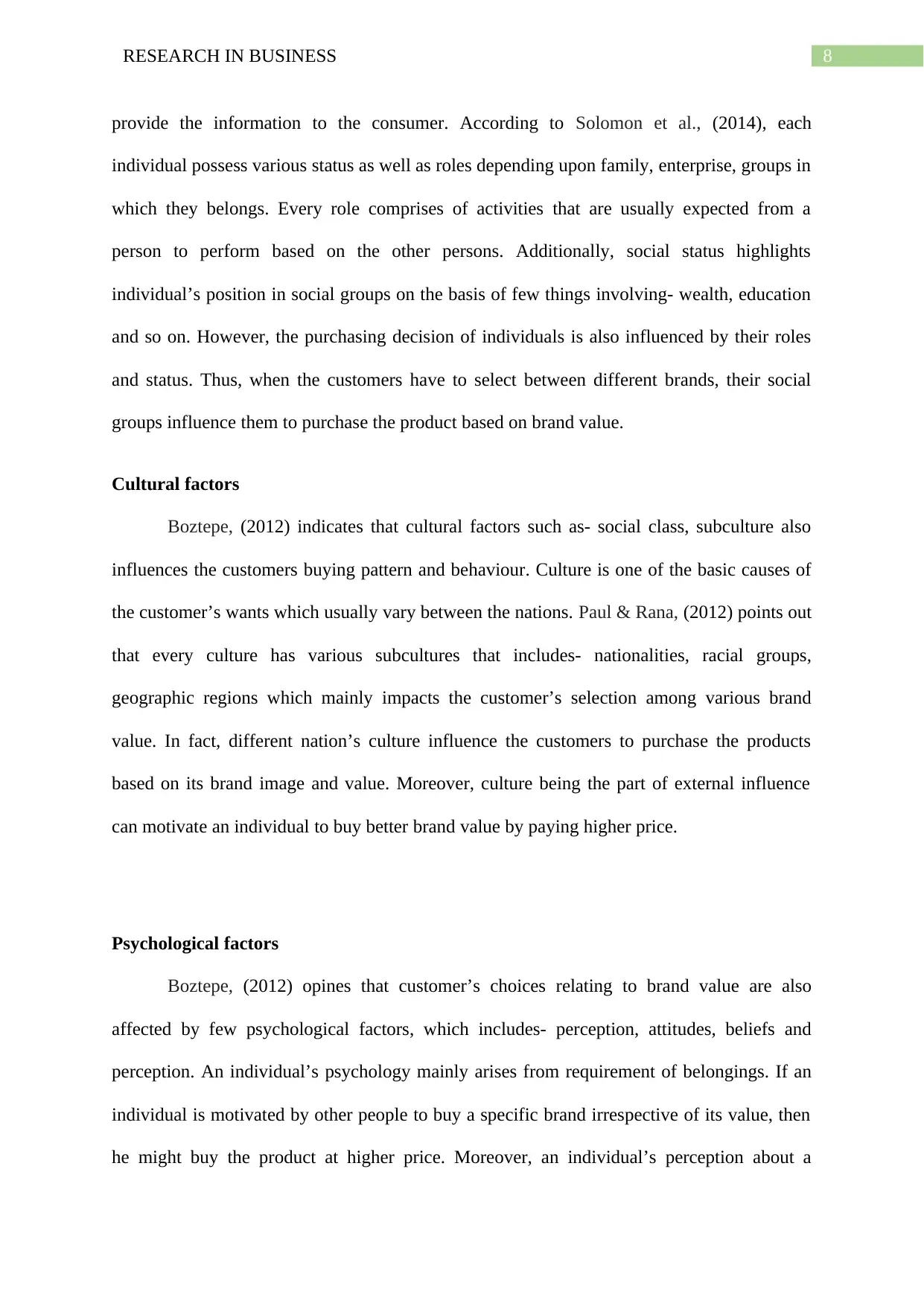
8RESEARCH IN BUSINESS
provide the information to the consumer. According to Solomon et al., (2014), each
individual possess various status as well as roles depending upon family, enterprise, groups in
which they belongs. Every role comprises of activities that are usually expected from a
person to perform based on the other persons. Additionally, social status highlights
individual’s position in social groups on the basis of few things involving- wealth, education
and so on. However, the purchasing decision of individuals is also influenced by their roles
and status. Thus, when the customers have to select between different brands, their social
groups influence them to purchase the product based on brand value.
Cultural factors
Boztepe, (2012) indicates that cultural factors such as- social class, subculture also
influences the customers buying pattern and behaviour. Culture is one of the basic causes of
the customer’s wants which usually vary between the nations. Paul & Rana, (2012) points out
that every culture has various subcultures that includes- nationalities, racial groups,
geographic regions which mainly impacts the customer’s selection among various brand
value. In fact, different nation’s culture influence the customers to purchase the products
based on its brand image and value. Moreover, culture being the part of external influence
can motivate an individual to buy better brand value by paying higher price.
Psychological factors
Boztepe, (2012) opines that customer’s choices relating to brand value are also
affected by few psychological factors, which includes- perception, attitudes, beliefs and
perception. An individual’s psychology mainly arises from requirement of belongings. If an
individual is motivated by other people to buy a specific brand irrespective of its value, then
he might buy the product at higher price. Moreover, an individual’s perception about a
provide the information to the consumer. According to Solomon et al., (2014), each
individual possess various status as well as roles depending upon family, enterprise, groups in
which they belongs. Every role comprises of activities that are usually expected from a
person to perform based on the other persons. Additionally, social status highlights
individual’s position in social groups on the basis of few things involving- wealth, education
and so on. However, the purchasing decision of individuals is also influenced by their roles
and status. Thus, when the customers have to select between different brands, their social
groups influence them to purchase the product based on brand value.
Cultural factors
Boztepe, (2012) indicates that cultural factors such as- social class, subculture also
influences the customers buying pattern and behaviour. Culture is one of the basic causes of
the customer’s wants which usually vary between the nations. Paul & Rana, (2012) points out
that every culture has various subcultures that includes- nationalities, racial groups,
geographic regions which mainly impacts the customer’s selection among various brand
value. In fact, different nation’s culture influence the customers to purchase the products
based on its brand image and value. Moreover, culture being the part of external influence
can motivate an individual to buy better brand value by paying higher price.
Psychological factors
Boztepe, (2012) opines that customer’s choices relating to brand value are also
affected by few psychological factors, which includes- perception, attitudes, beliefs and
perception. An individual’s psychology mainly arises from requirement of belongings. If an
individual is motivated by other people to buy a specific brand irrespective of its value, then
he might buy the product at higher price. Moreover, an individual’s perception about a
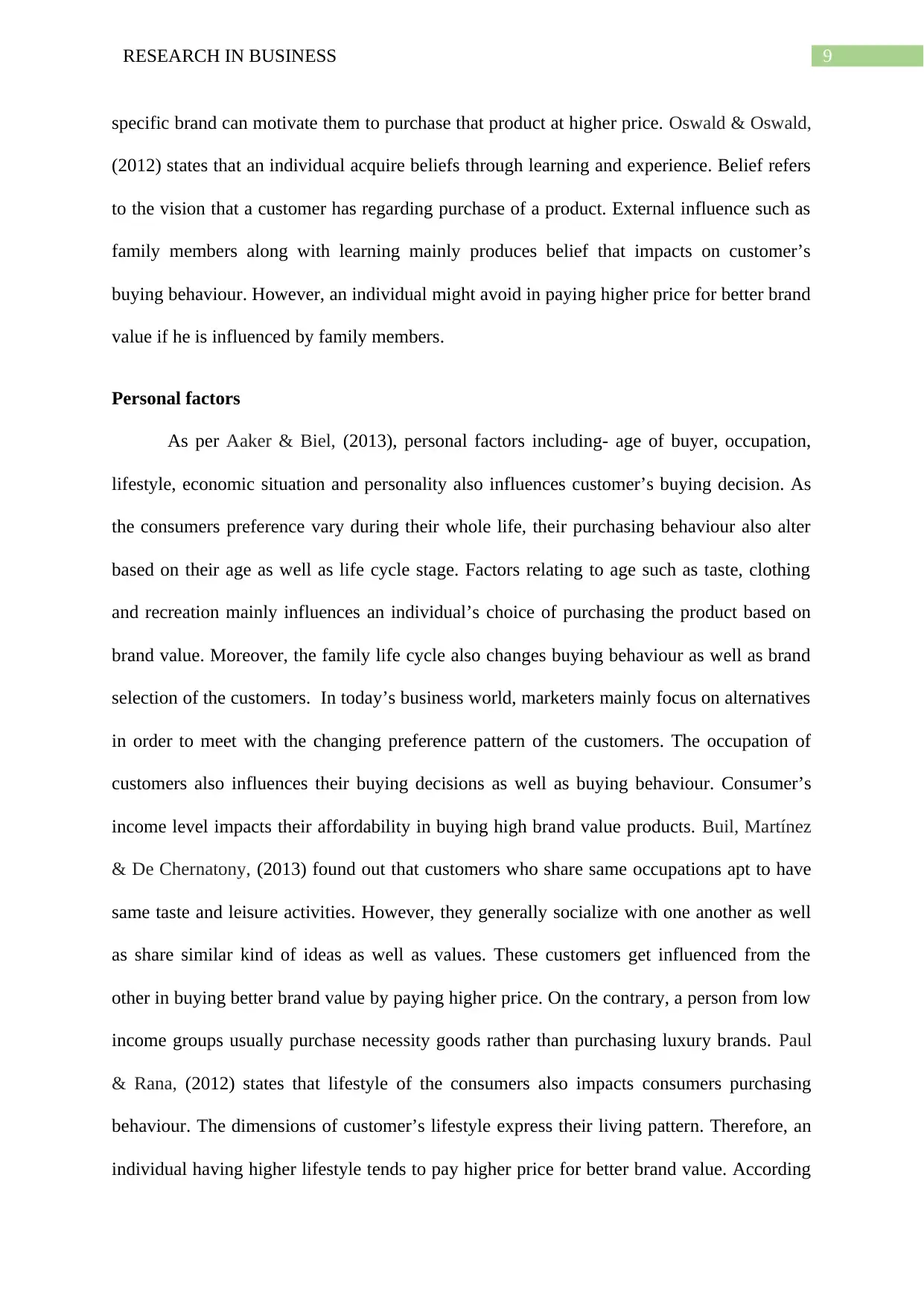
9RESEARCH IN BUSINESS
specific brand can motivate them to purchase that product at higher price. Oswald & Oswald,
(2012) states that an individual acquire beliefs through learning and experience. Belief refers
to the vision that a customer has regarding purchase of a product. External influence such as
family members along with learning mainly produces belief that impacts on customer’s
buying behaviour. However, an individual might avoid in paying higher price for better brand
value if he is influenced by family members.
Personal factors
As per Aaker & Biel, (2013), personal factors including- age of buyer, occupation,
lifestyle, economic situation and personality also influences customer’s buying decision. As
the consumers preference vary during their whole life, their purchasing behaviour also alter
based on their age as well as life cycle stage. Factors relating to age such as taste, clothing
and recreation mainly influences an individual’s choice of purchasing the product based on
brand value. Moreover, the family life cycle also changes buying behaviour as well as brand
selection of the customers. In today’s business world, marketers mainly focus on alternatives
in order to meet with the changing preference pattern of the customers. The occupation of
customers also influences their buying decisions as well as buying behaviour. Consumer’s
income level impacts their affordability in buying high brand value products. Buil, Martínez
& De Chernatony, (2013) found out that customers who share same occupations apt to have
same taste and leisure activities. However, they generally socialize with one another as well
as share similar kind of ideas as well as values. These customers get influenced from the
other in buying better brand value by paying higher price. On the contrary, a person from low
income groups usually purchase necessity goods rather than purchasing luxury brands. Paul
& Rana, (2012) states that lifestyle of the consumers also impacts consumers purchasing
behaviour. The dimensions of customer’s lifestyle express their living pattern. Therefore, an
individual having higher lifestyle tends to pay higher price for better brand value. According
specific brand can motivate them to purchase that product at higher price. Oswald & Oswald,
(2012) states that an individual acquire beliefs through learning and experience. Belief refers
to the vision that a customer has regarding purchase of a product. External influence such as
family members along with learning mainly produces belief that impacts on customer’s
buying behaviour. However, an individual might avoid in paying higher price for better brand
value if he is influenced by family members.
Personal factors
As per Aaker & Biel, (2013), personal factors including- age of buyer, occupation,
lifestyle, economic situation and personality also influences customer’s buying decision. As
the consumers preference vary during their whole life, their purchasing behaviour also alter
based on their age as well as life cycle stage. Factors relating to age such as taste, clothing
and recreation mainly influences an individual’s choice of purchasing the product based on
brand value. Moreover, the family life cycle also changes buying behaviour as well as brand
selection of the customers. In today’s business world, marketers mainly focus on alternatives
in order to meet with the changing preference pattern of the customers. The occupation of
customers also influences their buying decisions as well as buying behaviour. Consumer’s
income level impacts their affordability in buying high brand value products. Buil, Martínez
& De Chernatony, (2013) found out that customers who share same occupations apt to have
same taste and leisure activities. However, they generally socialize with one another as well
as share similar kind of ideas as well as values. These customers get influenced from the
other in buying better brand value by paying higher price. On the contrary, a person from low
income groups usually purchase necessity goods rather than purchasing luxury brands. Paul
& Rana, (2012) states that lifestyle of the consumers also impacts consumers purchasing
behaviour. The dimensions of customer’s lifestyle express their living pattern. Therefore, an
individual having higher lifestyle tends to pay higher price for better brand value. According
Secure Best Marks with AI Grader
Need help grading? Try our AI Grader for instant feedback on your assignments.

10RESEARCH IN BUSINESS
to Aaker & Biel, (2013), personality differs an individual from another with respect to their
traits, which involves- adaptability, dominance, self- confidence, sociability. An individual
attitude and value mainly shapes their personality which generally change during their whole
life. However, this change in personality of an individual impacts their way of thinking,
which in turn influences their purchasing behaviour based on brand value. Now- a-days
several brands have developed a proper image, which corresponds to values as well as traits
of customers. However, this permit the customers to express themselves with the help of
brand selection. Oswald & Oswald, (2012) cites that numerous dimensions of consumers
personality brings in brand amiability and also influences their purchasing pattern based on
brand image.
The factors that motivates consumers to pay higher price for better brand value are
explained below-
Brand image- This refers to the present view of consumers about a specific brand. Paul &
Rana, (2012) cites that brand image consists of different associations in customer’s minds
regarding attributes, benefits. It includes- appearance of product, functionality and value and
is mainly brand content. If the brand image is higher, then it increases product brand value.
As a result, this motivates customers to pay high price for higher brand value (Anselmsson,
Vestman Bondesson, & Johansson, 2014).
Brand awareness- This is highlighted in ability of consumers to recognize proper brand
under various situations involving- brand recognition, brand opinion. Oswald & Oswald,
(2012) states that it is one of the vital pillars of developing brand equity. It is taken into
account as important in low involvement goods categories and is attributed to each consumer.
It has been evident from several studies that brand awareness motivate customers to pay high
price for high brand value.
to Aaker & Biel, (2013), personality differs an individual from another with respect to their
traits, which involves- adaptability, dominance, self- confidence, sociability. An individual
attitude and value mainly shapes their personality which generally change during their whole
life. However, this change in personality of an individual impacts their way of thinking,
which in turn influences their purchasing behaviour based on brand value. Now- a-days
several brands have developed a proper image, which corresponds to values as well as traits
of customers. However, this permit the customers to express themselves with the help of
brand selection. Oswald & Oswald, (2012) cites that numerous dimensions of consumers
personality brings in brand amiability and also influences their purchasing pattern based on
brand image.
The factors that motivates consumers to pay higher price for better brand value are
explained below-
Brand image- This refers to the present view of consumers about a specific brand. Paul &
Rana, (2012) cites that brand image consists of different associations in customer’s minds
regarding attributes, benefits. It includes- appearance of product, functionality and value and
is mainly brand content. If the brand image is higher, then it increases product brand value.
As a result, this motivates customers to pay high price for higher brand value (Anselmsson,
Vestman Bondesson, & Johansson, 2014).
Brand awareness- This is highlighted in ability of consumers to recognize proper brand
under various situations involving- brand recognition, brand opinion. Oswald & Oswald,
(2012) states that it is one of the vital pillars of developing brand equity. It is taken into
account as important in low involvement goods categories and is attributed to each consumer.
It has been evident from several studies that brand awareness motivate customers to pay high
price for high brand value.

11RESEARCH IN BUSINESS
Quality- Severi & Ling, (2013) cites that good quality products also motivates the customers
to buy that product irrespective of higher price. The enterprises are now- a- days adopting
advanced technologies to produce quality products as it increases brand value in market and
motivate customers to pay high price for better brand value.
Uniqueness-This means the products are made unique by the enterprise in terms of design,
quality, brand and packaging in order to attract large number of customers. However, unique
selling proposition of a brand increases it value in the market, which in turn motivates the
consumers to pay high price for high brand value (Buil, De Chernatony & Martínez, 2013).
Conceptual Framework
Research Methodology
This section focuses on the various methods or tools that are to be integrated while
conducting this specific research study (Choy, 2014). These methods include- research
philosophy, research design, research method, data collection method and sampling size. In
Quality- Severi & Ling, (2013) cites that good quality products also motivates the customers
to buy that product irrespective of higher price. The enterprises are now- a- days adopting
advanced technologies to produce quality products as it increases brand value in market and
motivate customers to pay high price for better brand value.
Uniqueness-This means the products are made unique by the enterprise in terms of design,
quality, brand and packaging in order to attract large number of customers. However, unique
selling proposition of a brand increases it value in the market, which in turn motivates the
consumers to pay high price for high brand value (Buil, De Chernatony & Martínez, 2013).
Conceptual Framework
Research Methodology
This section focuses on the various methods or tools that are to be integrated while
conducting this specific research study (Choy, 2014). These methods include- research
philosophy, research design, research method, data collection method and sampling size. In
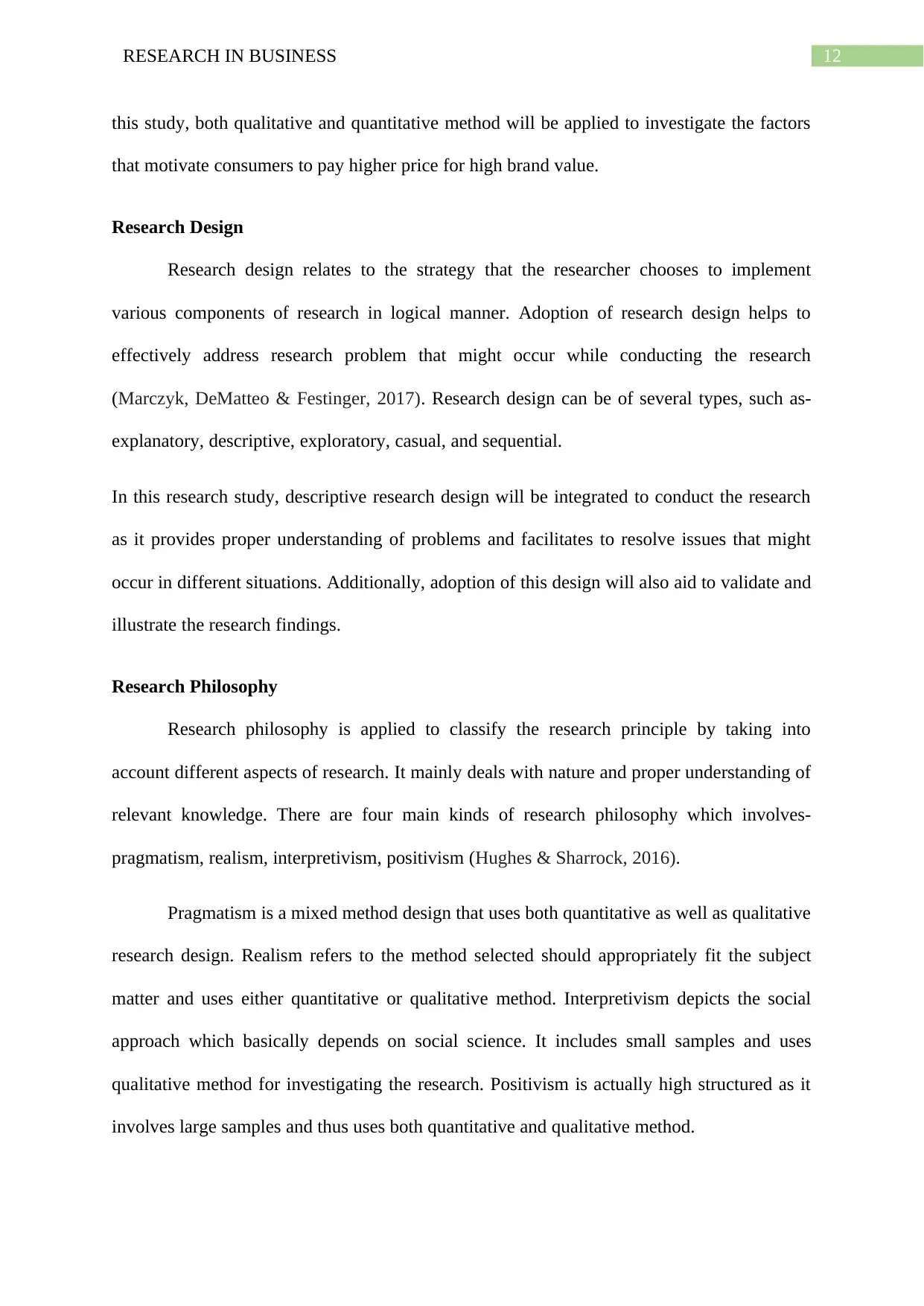
12RESEARCH IN BUSINESS
this study, both qualitative and quantitative method will be applied to investigate the factors
that motivate consumers to pay higher price for high brand value.
Research Design
Research design relates to the strategy that the researcher chooses to implement
various components of research in logical manner. Adoption of research design helps to
effectively address research problem that might occur while conducting the research
(Marczyk, DeMatteo & Festinger, 2017). Research design can be of several types, such as-
explanatory, descriptive, exploratory, casual, and sequential.
In this research study, descriptive research design will be integrated to conduct the research
as it provides proper understanding of problems and facilitates to resolve issues that might
occur in different situations. Additionally, adoption of this design will also aid to validate and
illustrate the research findings.
Research Philosophy
Research philosophy is applied to classify the research principle by taking into
account different aspects of research. It mainly deals with nature and proper understanding of
relevant knowledge. There are four main kinds of research philosophy which involves-
pragmatism, realism, interpretivism, positivism (Hughes & Sharrock, 2016).
Pragmatism is a mixed method design that uses both quantitative as well as qualitative
research design. Realism refers to the method selected should appropriately fit the subject
matter and uses either quantitative or qualitative method. Interpretivism depicts the social
approach which basically depends on social science. It includes small samples and uses
qualitative method for investigating the research. Positivism is actually high structured as it
involves large samples and thus uses both quantitative and qualitative method.
this study, both qualitative and quantitative method will be applied to investigate the factors
that motivate consumers to pay higher price for high brand value.
Research Design
Research design relates to the strategy that the researcher chooses to implement
various components of research in logical manner. Adoption of research design helps to
effectively address research problem that might occur while conducting the research
(Marczyk, DeMatteo & Festinger, 2017). Research design can be of several types, such as-
explanatory, descriptive, exploratory, casual, and sequential.
In this research study, descriptive research design will be integrated to conduct the research
as it provides proper understanding of problems and facilitates to resolve issues that might
occur in different situations. Additionally, adoption of this design will also aid to validate and
illustrate the research findings.
Research Philosophy
Research philosophy is applied to classify the research principle by taking into
account different aspects of research. It mainly deals with nature and proper understanding of
relevant knowledge. There are four main kinds of research philosophy which involves-
pragmatism, realism, interpretivism, positivism (Hughes & Sharrock, 2016).
Pragmatism is a mixed method design that uses both quantitative as well as qualitative
research design. Realism refers to the method selected should appropriately fit the subject
matter and uses either quantitative or qualitative method. Interpretivism depicts the social
approach which basically depends on social science. It includes small samples and uses
qualitative method for investigating the research. Positivism is actually high structured as it
involves large samples and thus uses both quantitative and qualitative method.
Paraphrase This Document
Need a fresh take? Get an instant paraphrase of this document with our AI Paraphraser
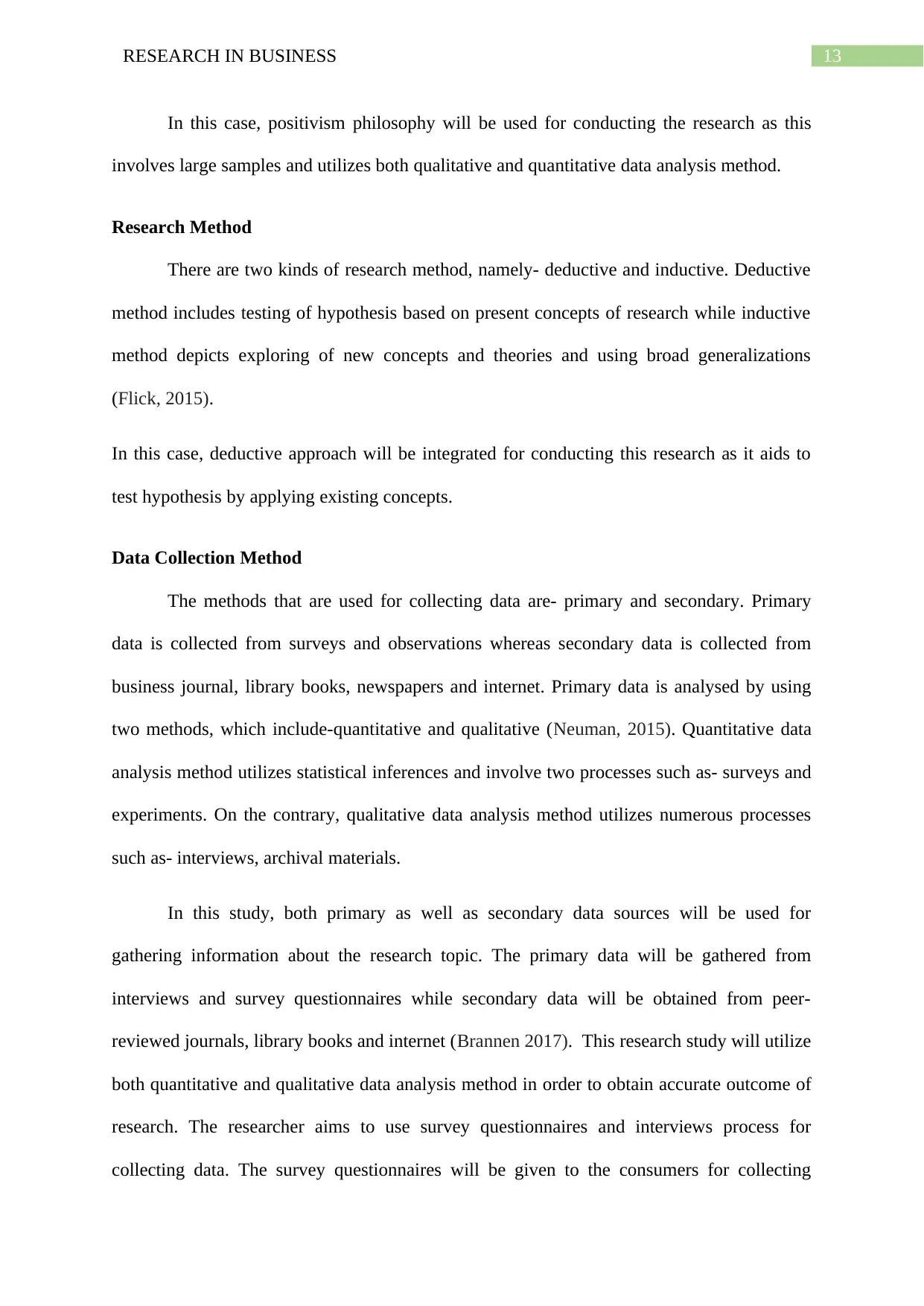
13RESEARCH IN BUSINESS
In this case, positivism philosophy will be used for conducting the research as this
involves large samples and utilizes both qualitative and quantitative data analysis method.
Research Method
There are two kinds of research method, namely- deductive and inductive. Deductive
method includes testing of hypothesis based on present concepts of research while inductive
method depicts exploring of new concepts and theories and using broad generalizations
(Flick, 2015).
In this case, deductive approach will be integrated for conducting this research as it aids to
test hypothesis by applying existing concepts.
Data Collection Method
The methods that are used for collecting data are- primary and secondary. Primary
data is collected from surveys and observations whereas secondary data is collected from
business journal, library books, newspapers and internet. Primary data is analysed by using
two methods, which include-quantitative and qualitative (Neuman, 2015). Quantitative data
analysis method utilizes statistical inferences and involve two processes such as- surveys and
experiments. On the contrary, qualitative data analysis method utilizes numerous processes
such as- interviews, archival materials.
In this study, both primary as well as secondary data sources will be used for
gathering information about the research topic. The primary data will be gathered from
interviews and survey questionnaires while secondary data will be obtained from peer-
reviewed journals, library books and internet (Brannen 2017). This research study will utilize
both quantitative and qualitative data analysis method in order to obtain accurate outcome of
research. The researcher aims to use survey questionnaires and interviews process for
collecting data. The survey questionnaires will be given to the consumers for collecting
In this case, positivism philosophy will be used for conducting the research as this
involves large samples and utilizes both qualitative and quantitative data analysis method.
Research Method
There are two kinds of research method, namely- deductive and inductive. Deductive
method includes testing of hypothesis based on present concepts of research while inductive
method depicts exploring of new concepts and theories and using broad generalizations
(Flick, 2015).
In this case, deductive approach will be integrated for conducting this research as it aids to
test hypothesis by applying existing concepts.
Data Collection Method
The methods that are used for collecting data are- primary and secondary. Primary
data is collected from surveys and observations whereas secondary data is collected from
business journal, library books, newspapers and internet. Primary data is analysed by using
two methods, which include-quantitative and qualitative (Neuman, 2015). Quantitative data
analysis method utilizes statistical inferences and involve two processes such as- surveys and
experiments. On the contrary, qualitative data analysis method utilizes numerous processes
such as- interviews, archival materials.
In this study, both primary as well as secondary data sources will be used for
gathering information about the research topic. The primary data will be gathered from
interviews and survey questionnaires while secondary data will be obtained from peer-
reviewed journals, library books and internet (Brannen 2017). This research study will utilize
both quantitative and qualitative data analysis method in order to obtain accurate outcome of
research. The researcher aims to use survey questionnaires and interviews process for
collecting data. The survey questionnaires will be given to the consumers for collecting
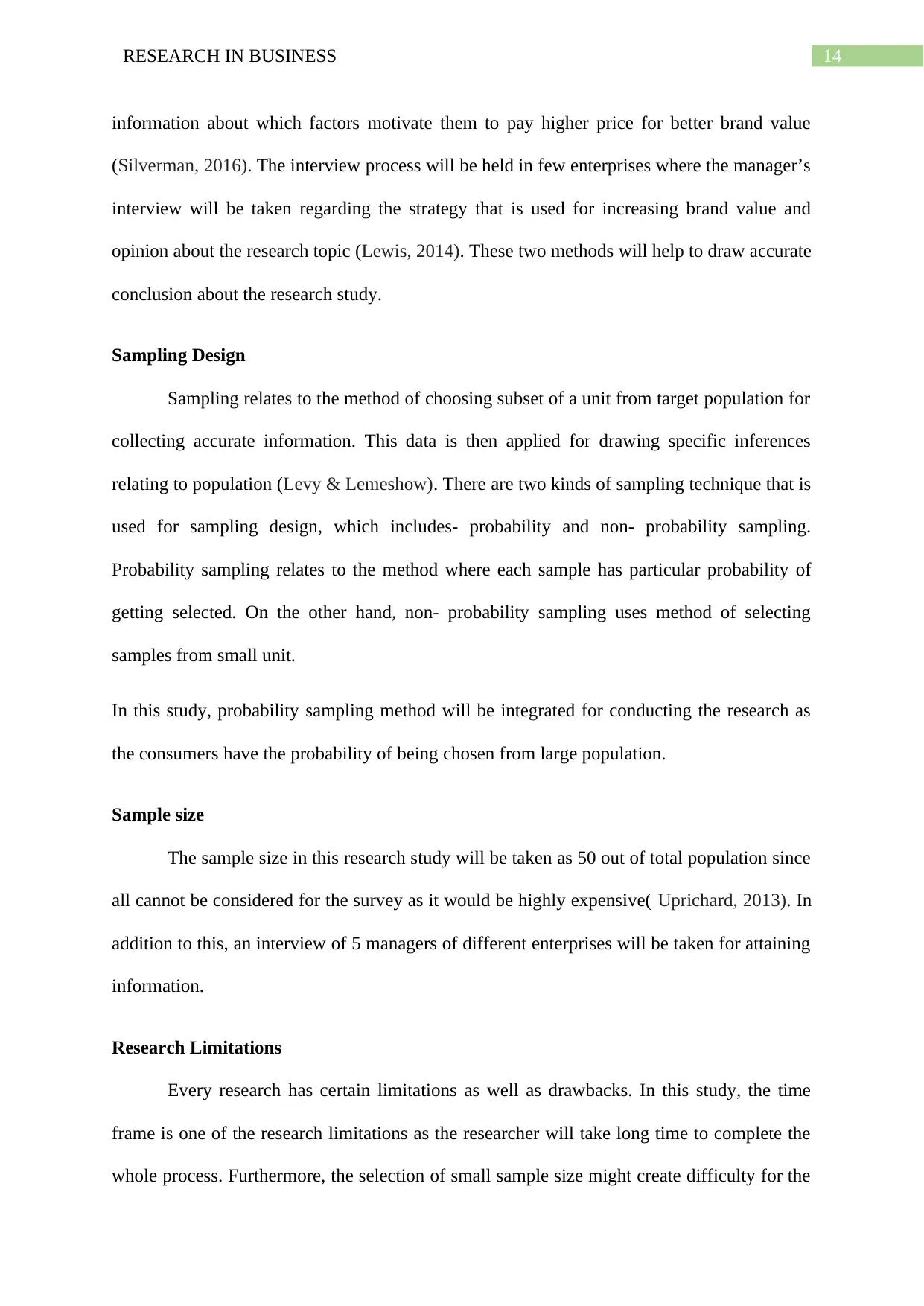
14RESEARCH IN BUSINESS
information about which factors motivate them to pay higher price for better brand value
(Silverman, 2016). The interview process will be held in few enterprises where the manager’s
interview will be taken regarding the strategy that is used for increasing brand value and
opinion about the research topic (Lewis, 2014). These two methods will help to draw accurate
conclusion about the research study.
Sampling Design
Sampling relates to the method of choosing subset of a unit from target population for
collecting accurate information. This data is then applied for drawing specific inferences
relating to population (Levy & Lemeshow). There are two kinds of sampling technique that is
used for sampling design, which includes- probability and non- probability sampling.
Probability sampling relates to the method where each sample has particular probability of
getting selected. On the other hand, non- probability sampling uses method of selecting
samples from small unit.
In this study, probability sampling method will be integrated for conducting the research as
the consumers have the probability of being chosen from large population.
Sample size
The sample size in this research study will be taken as 50 out of total population since
all cannot be considered for the survey as it would be highly expensive( Uprichard, 2013). In
addition to this, an interview of 5 managers of different enterprises will be taken for attaining
information.
Research Limitations
Every research has certain limitations as well as drawbacks. In this study, the time
frame is one of the research limitations as the researcher will take long time to complete the
whole process. Furthermore, the selection of small sample size might create difficulty for the
information about which factors motivate them to pay higher price for better brand value
(Silverman, 2016). The interview process will be held in few enterprises where the manager’s
interview will be taken regarding the strategy that is used for increasing brand value and
opinion about the research topic (Lewis, 2014). These two methods will help to draw accurate
conclusion about the research study.
Sampling Design
Sampling relates to the method of choosing subset of a unit from target population for
collecting accurate information. This data is then applied for drawing specific inferences
relating to population (Levy & Lemeshow). There are two kinds of sampling technique that is
used for sampling design, which includes- probability and non- probability sampling.
Probability sampling relates to the method where each sample has particular probability of
getting selected. On the other hand, non- probability sampling uses method of selecting
samples from small unit.
In this study, probability sampling method will be integrated for conducting the research as
the consumers have the probability of being chosen from large population.
Sample size
The sample size in this research study will be taken as 50 out of total population since
all cannot be considered for the survey as it would be highly expensive( Uprichard, 2013). In
addition to this, an interview of 5 managers of different enterprises will be taken for attaining
information.
Research Limitations
Every research has certain limitations as well as drawbacks. In this study, the time
frame is one of the research limitations as the researcher will take long time to complete the
whole process. Furthermore, the selection of small sample size might create difficulty for the
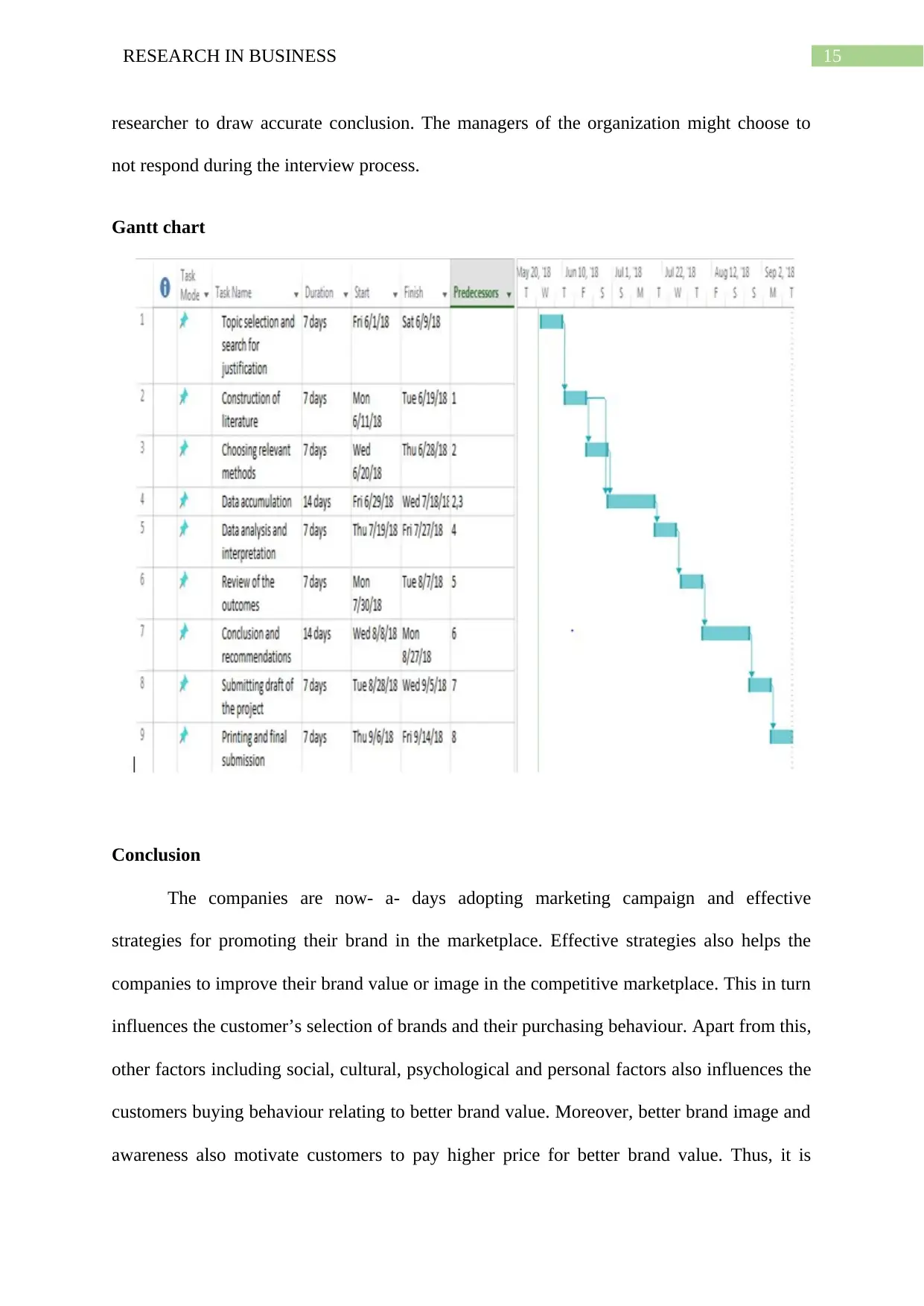
15RESEARCH IN BUSINESS
researcher to draw accurate conclusion. The managers of the organization might choose to
not respond during the interview process.
Gantt chart
Conclusion
The companies are now- a- days adopting marketing campaign and effective
strategies for promoting their brand in the marketplace. Effective strategies also helps the
companies to improve their brand value or image in the competitive marketplace. This in turn
influences the customer’s selection of brands and their purchasing behaviour. Apart from this,
other factors including social, cultural, psychological and personal factors also influences the
customers buying behaviour relating to better brand value. Moreover, better brand image and
awareness also motivate customers to pay higher price for better brand value. Thus, it is
researcher to draw accurate conclusion. The managers of the organization might choose to
not respond during the interview process.
Gantt chart
Conclusion
The companies are now- a- days adopting marketing campaign and effective
strategies for promoting their brand in the marketplace. Effective strategies also helps the
companies to improve their brand value or image in the competitive marketplace. This in turn
influences the customer’s selection of brands and their purchasing behaviour. Apart from this,
other factors including social, cultural, psychological and personal factors also influences the
customers buying behaviour relating to better brand value. Moreover, better brand image and
awareness also motivate customers to pay higher price for better brand value. Thus, it is
Secure Best Marks with AI Grader
Need help grading? Try our AI Grader for instant feedback on your assignments.

16RESEARCH IN BUSINESS
necessary for the enterprise to focus on their marketing and pricing strategies in order to
improve their brand value and image in the market.
necessary for the enterprise to focus on their marketing and pricing strategies in order to
improve their brand value and image in the market.
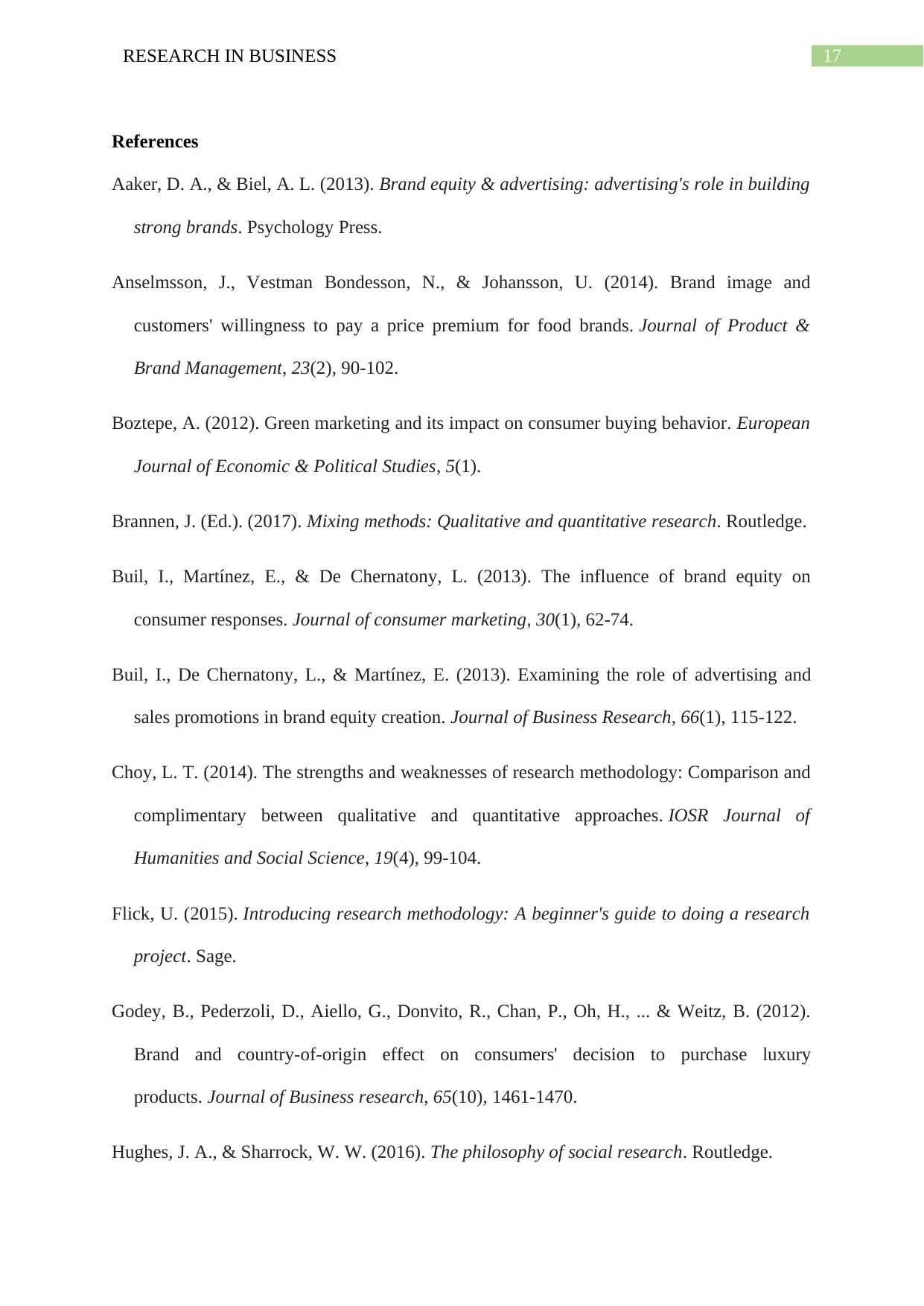
17RESEARCH IN BUSINESS
References
Aaker, D. A., & Biel, A. L. (2013). Brand equity & advertising: advertising's role in building
strong brands. Psychology Press.
Anselmsson, J., Vestman Bondesson, N., & Johansson, U. (2014). Brand image and
customers' willingness to pay a price premium for food brands. Journal of Product &
Brand Management, 23(2), 90-102.
Boztepe, A. (2012). Green marketing and its impact on consumer buying behavior. European
Journal of Economic & Political Studies, 5(1).
Brannen, J. (Ed.). (2017). Mixing methods: Qualitative and quantitative research. Routledge.
Buil, I., Martínez, E., & De Chernatony, L. (2013). The influence of brand equity on
consumer responses. Journal of consumer marketing, 30(1), 62-74.
Buil, I., De Chernatony, L., & Martínez, E. (2013). Examining the role of advertising and
sales promotions in brand equity creation. Journal of Business Research, 66(1), 115-122.
Choy, L. T. (2014). The strengths and weaknesses of research methodology: Comparison and
complimentary between qualitative and quantitative approaches. IOSR Journal of
Humanities and Social Science, 19(4), 99-104.
Flick, U. (2015). Introducing research methodology: A beginner's guide to doing a research
project. Sage.
Godey, B., Pederzoli, D., Aiello, G., Donvito, R., Chan, P., Oh, H., ... & Weitz, B. (2012).
Brand and country-of-origin effect on consumers' decision to purchase luxury
products. Journal of Business research, 65(10), 1461-1470.
Hughes, J. A., & Sharrock, W. W. (2016). The philosophy of social research. Routledge.
References
Aaker, D. A., & Biel, A. L. (2013). Brand equity & advertising: advertising's role in building
strong brands. Psychology Press.
Anselmsson, J., Vestman Bondesson, N., & Johansson, U. (2014). Brand image and
customers' willingness to pay a price premium for food brands. Journal of Product &
Brand Management, 23(2), 90-102.
Boztepe, A. (2012). Green marketing and its impact on consumer buying behavior. European
Journal of Economic & Political Studies, 5(1).
Brannen, J. (Ed.). (2017). Mixing methods: Qualitative and quantitative research. Routledge.
Buil, I., Martínez, E., & De Chernatony, L. (2013). The influence of brand equity on
consumer responses. Journal of consumer marketing, 30(1), 62-74.
Buil, I., De Chernatony, L., & Martínez, E. (2013). Examining the role of advertising and
sales promotions in brand equity creation. Journal of Business Research, 66(1), 115-122.
Choy, L. T. (2014). The strengths and weaknesses of research methodology: Comparison and
complimentary between qualitative and quantitative approaches. IOSR Journal of
Humanities and Social Science, 19(4), 99-104.
Flick, U. (2015). Introducing research methodology: A beginner's guide to doing a research
project. Sage.
Godey, B., Pederzoli, D., Aiello, G., Donvito, R., Chan, P., Oh, H., ... & Weitz, B. (2012).
Brand and country-of-origin effect on consumers' decision to purchase luxury
products. Journal of Business research, 65(10), 1461-1470.
Hughes, J. A., & Sharrock, W. W. (2016). The philosophy of social research. Routledge.
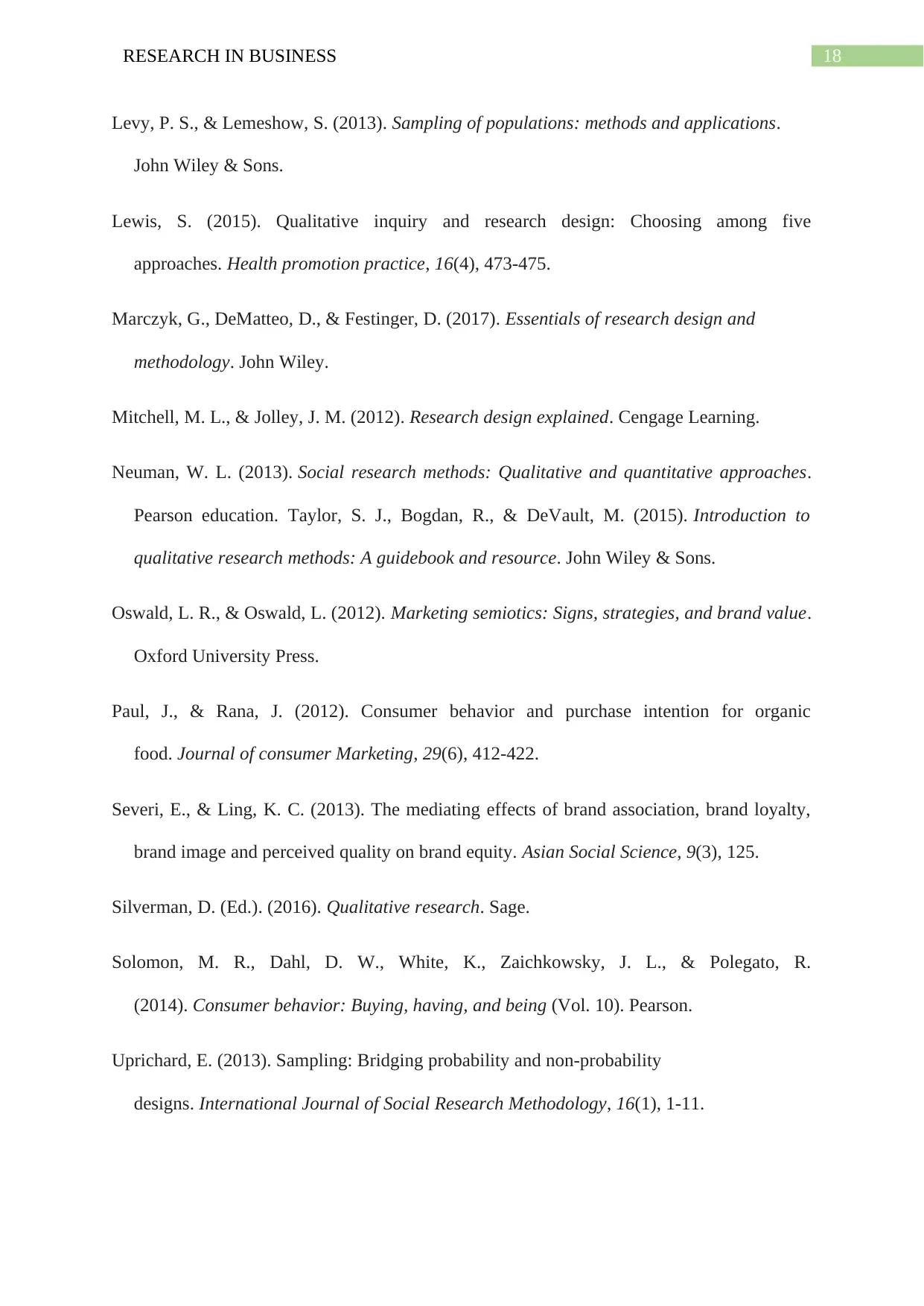
18RESEARCH IN BUSINESS
Levy, P. S., & Lemeshow, S. (2013). Sampling of populations: methods and applications.
John Wiley & Sons.
Lewis, S. (2015). Qualitative inquiry and research design: Choosing among five
approaches. Health promotion practice, 16(4), 473-475.
Marczyk, G., DeMatteo, D., & Festinger, D. (2017). Essentials of research design and
methodology. John Wiley.
Mitchell, M. L., & Jolley, J. M. (2012). Research design explained. Cengage Learning.
Neuman, W. L. (2013). Social research methods: Qualitative and quantitative approaches.
Pearson education. Taylor, S. J., Bogdan, R., & DeVault, M. (2015). Introduction to
qualitative research methods: A guidebook and resource. John Wiley & Sons.
Oswald, L. R., & Oswald, L. (2012). Marketing semiotics: Signs, strategies, and brand value.
Oxford University Press.
Paul, J., & Rana, J. (2012). Consumer behavior and purchase intention for organic
food. Journal of consumer Marketing, 29(6), 412-422.
Severi, E., & Ling, K. C. (2013). The mediating effects of brand association, brand loyalty,
brand image and perceived quality on brand equity. Asian Social Science, 9(3), 125.
Silverman, D. (Ed.). (2016). Qualitative research. Sage.
Solomon, M. R., Dahl, D. W., White, K., Zaichkowsky, J. L., & Polegato, R.
(2014). Consumer behavior: Buying, having, and being (Vol. 10). Pearson.
Uprichard, E. (2013). Sampling: Bridging probability and non-probability
designs. International Journal of Social Research Methodology, 16(1), 1-11.
Levy, P. S., & Lemeshow, S. (2013). Sampling of populations: methods and applications.
John Wiley & Sons.
Lewis, S. (2015). Qualitative inquiry and research design: Choosing among five
approaches. Health promotion practice, 16(4), 473-475.
Marczyk, G., DeMatteo, D., & Festinger, D. (2017). Essentials of research design and
methodology. John Wiley.
Mitchell, M. L., & Jolley, J. M. (2012). Research design explained. Cengage Learning.
Neuman, W. L. (2013). Social research methods: Qualitative and quantitative approaches.
Pearson education. Taylor, S. J., Bogdan, R., & DeVault, M. (2015). Introduction to
qualitative research methods: A guidebook and resource. John Wiley & Sons.
Oswald, L. R., & Oswald, L. (2012). Marketing semiotics: Signs, strategies, and brand value.
Oxford University Press.
Paul, J., & Rana, J. (2012). Consumer behavior and purchase intention for organic
food. Journal of consumer Marketing, 29(6), 412-422.
Severi, E., & Ling, K. C. (2013). The mediating effects of brand association, brand loyalty,
brand image and perceived quality on brand equity. Asian Social Science, 9(3), 125.
Silverman, D. (Ed.). (2016). Qualitative research. Sage.
Solomon, M. R., Dahl, D. W., White, K., Zaichkowsky, J. L., & Polegato, R.
(2014). Consumer behavior: Buying, having, and being (Vol. 10). Pearson.
Uprichard, E. (2013). Sampling: Bridging probability and non-probability
designs. International Journal of Social Research Methodology, 16(1), 1-11.
1 out of 19
Related Documents
Your All-in-One AI-Powered Toolkit for Academic Success.
+13062052269
info@desklib.com
Available 24*7 on WhatsApp / Email
![[object Object]](/_next/static/media/star-bottom.7253800d.svg)
Unlock your academic potential
© 2024 | Zucol Services PVT LTD | All rights reserved.




